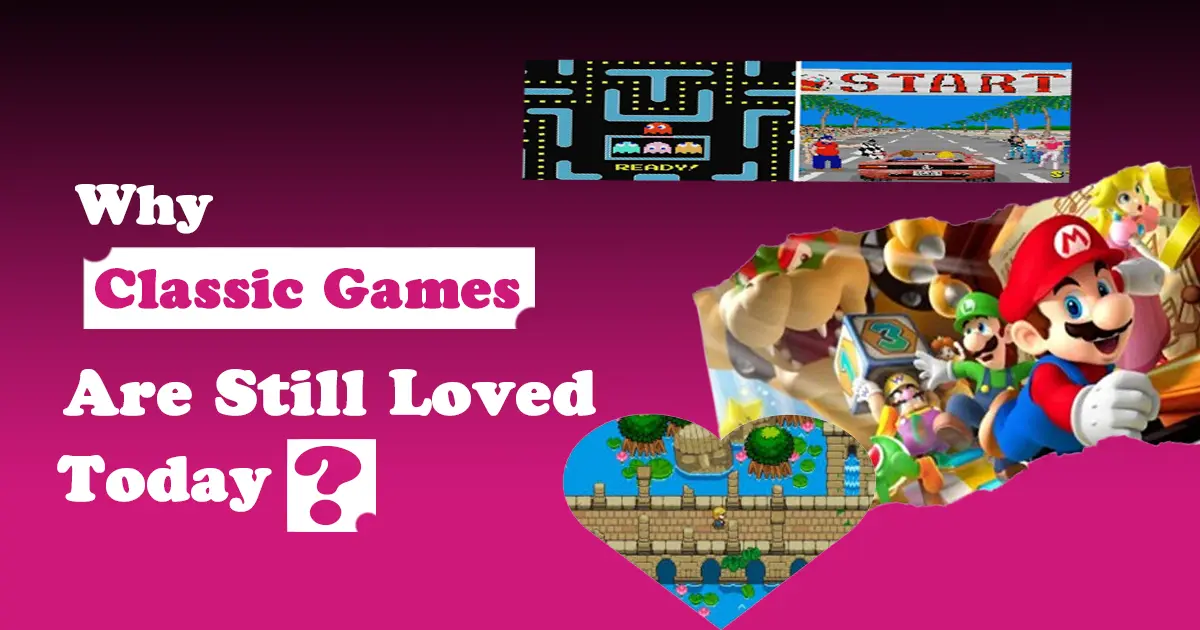While hyper-realistic graphics, cloud gaming, and complex storylines might make one think that antiquity erodes into obscurity, the real story goes quite the other way. From pixelated arcade games to those early console hits, classic games stand tall in the hearts of practitioners across all generations. This lingering attraction raises an interesting question: Why do classic games still hold such esteem today? This article will analyze the reasons classic games are still popular today and why they are still cherished in the hearts of gamers around the world.
1. Nostalgia: A Powerful Emotional Connection
Nostalgia is one of the strongest reasons why gaming enthusiasts adore classic games. These games are linked with fond childhood memories for many: playing Super Mario Bros. with siblings, battling Street Fighter in local arcades, or Pokémon-ing for hours on a Game Boy.
These memories were not just gameplay but emotional experiences. Classic gaming puts players in touch with their younger selves, allowing them to savor memories of simpler days.
“When playing any classic game, it’s as though one is letting loose a time capsule- to remind them of who they were with, where they were, and what they were feeling.”
2. Simplicity That Never Gets Old
Classics are known for their simple yet captivating and addictive gameplay. Unlike most contemporary games, which can often take hours of tutorials, updates, and in-depth mechanics to get going before they sink themselves into you, these retro games get into gameplay. Jump, shoot, score—it’s all quite intuitive.
This unpretentiousness does not work to its detriment; it enhances the goodwill of such games. Just take a look at Tetris, Pac-Man, or Sonic the Hedgehog: none of these games needed 4K graphics or a dramatic story arc to entertain.
3. Timeless Design and Iconic Characters
Old-school games birthed a myriad of iconic characters and designs that are legendary in the gaming world. Just think of Mario, Link, Donkey Kong, Mega Man, and Lara Croft-these quickly moved above gaming into global pop culture.
And then, there are the advanced game mechanics and level designs; quite simply, they were ahead of their time, and even some current well-famed games draw their roots from the designs laid by the classic games. For example, any modern platformers, side-scrolling games, or turn-based strategy games owe their existence to some extent to the designs established by the classic games.
4. Challenging Gameplay That Tests Skill
The old-fashioned games were very hard to play. Games like Contra, Ghosts’ n’ Goblins, and Ninja Gaiden asked for nothing less than impeccable timing, reflexes, and foresight. No save points, no easy modes—just you against the game.
That feeling of accomplishment is what the players lived for. Beating a retro game is not only fun, it is also an achievement. It is this very difficulty that still appeals to modern players, who want to test their skills.
5. Community and Collectability
It is indeed vibrant and pretty much alive. Such retro gaming communities include forums, YouTube channels, Reddit groups, and Facebook communities. All these pay homage to the enthusiastic retro gaming fans, share experiences about organizing tips on classics, and house amazing collection photos of vintage items.
The collectability of a classic game adds much more to its appeal, and so many people run after rare cartridges, consoles, or limited-edition releases. Having an original copy of a vintage video game, particularly one that is in mint condition, is valued as a treasure.
6. The Rise of Retro Gaming Culture
A recent trend may well be turning retro gaming into more than just an activity – it is now a culture. Mini consoles (such as NES Classic, SNES Classic, and Sega Genesis Mini), retro-game emulators, and remasters of the classics, for instance, have marked the new generation with the magic of classic games.
Even new games developed these days are done in retro style pixel art and filled with chiptune songs for those players who enjoy the aesthetics and feeling of old games.
7. Affordability and Accessibility
Compared to AAA, most classic games are cheaper and more accessible. Emulators and digital stores give players access to hundreds of titles without spending a fortune. In addition, many older titles have low system requirements and can run even on basic PCs, phones, or handheld devices.
This low entry barrier makes classic games attractive, especially for casual players or people looking into the hobby for the first time.
8. Preservation of Gaming History
Old school-style games are the basis of the video game industry. Playing and keeping the classics is not just fun, it’s also a way to understand how far gaming has come. Games like Pong, Space Invaders, and Doom were milestones, defining how we play and think about games today.
Gamers, collectors, and historians alike are working together to save the digital gaming heritage, making sure these experiences live through the years and not become tainted by out-of-date technology or corporate decisions.
9. Cross-Generational Appeal
Games that belong to the category of classic games show a wonderful quality of connecting generations. Parents playing with their children will undoubtedly remember the 8-bit and 16-bit games that they played once. Specifically, these games are remembered for several titles that they found exciting. Therefore, this creates a very good bonding experience, but the most important thing is that classic games have a wonderful lifeline that continues among the young and the old.
10. Remakes and Reboots Keep the Spirit Alive
Developers always observe the fondness of people for classic games; therefore, they tend to develop remakes, remasters, and reboots. Updated versions sound modern, but at the same time keep the original essence intact. Some exemplary examples are Final Fantasy VII Remake, Crash Bandicoot: N. Sane Trilogy, and The Legend of Zelda: Link’s Awakening.
These re-invented classics are indeed aimed at old-school aficionados as much as they are at new-wave players who are experiencing the most iconic titles for the first time, still feeding the fire of appreciation.
Conclusion: A Legacy That Lives On
They have a solid gaming history well beyond old titles. They’re packed with nostalgia, challenge, creativity, and charm. Proof that innovation and legacy coexist is in their ongoing popularity. Modern games today are cutting-edge and playthings of the past. But a love for them lives on because they offer something, time less-pure and simply fun gameplay with feeling.
Whether you are a retro gaming fanatic or a novice, classic games will remind everyone what it was that once captured their hearts. As long as love remains, the classics will never die.

